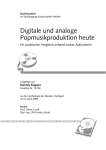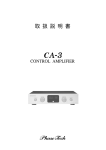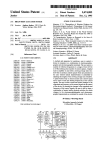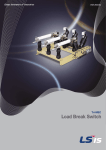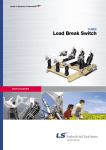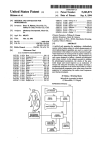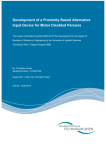Download Rupert Neve Portico II Specifications
Transcript
5052 Mic Pre / Inductor EQ Serial #: Operations Manual 5052 Mic Pre / Inductor EQ Thank you for your purchase of the 5052 Mic Pre / Inductor EQ. Everyone at Rupert Neve Designs hopes you enjoy using this tool as much as we have enjoyed designing and building it. Please take note of the following list of safety concerns and power requirements before the use of this product. Safety It’s usual to provide a list of “do’s and don’ts” under this heading but mostly these amount to common sense issues. However here are some reminders: Don’t operate your 5052 module in or around water! Electronic equipment and liquids are not good friends. If any liquid is spilled such as soda, coffee, alcoholic or other drink, the sugars and acids will have a very detrimental effect. Sugar crystals act like little rectifiers and can produce noise (crackles, etc.). SWITCH OFF IMMEDIATELY because once current starts to flow, the mixture hardens, can get very hot (burnt toffee!) and cause permanent and costly damage. Please contact support as soon as possible at [email protected] for resolution. Safety Instructions: 1) Read these instructions. 2) Keep these instructions. 3) Heed all warnings. 4) Follow all instructions. 5) Do not use this apparatus near water. 6) Clean only with dry cloth. 7) Do not block any ventilation openings. Install in accordance with the manufacturer’s instructions. 8) Do not install near any heat source such as radiators, heat registers, stoves, or other apparatus (including amplifiers) that produce heat. 9) Do not defeat the safety purpose of the polarized or grounding-type plug. A polarized plug has two blades with one wider than the other. A grounding type plug has two blades and a third grounding prong. The wide blade or the third prong are provided for your safety. If the provided plug does not fit into your outlet, consult an electrician for replacement of the obsolete outlet. 10) Protect the power cord from being walked on or pinched, particularly at plugs convenience receptacles and the point where they exit from the apparatus. 11) Only use attachments/accessories specified by the manufacturer. 12) Unplug this apparatus during lightning storms or when unused for long periods of time. 13) Refer all servicing to qualified service personnel. Servicing is required when the apparatus has been damaged in any way, such as when power-supply cord or plug is damaged, liquid has been spilled or objects have fallen into the apparatus, the apparatus has been exposed to rain or moisture, does not operate normally, or has been dropped. 14) Do not expose this apparatus to rain or moisture. 15) The apparatus shall be connected to a mains socket outlet with a protective earthing connection. 5052: Front Panel 5052 Mic Pre/EQ Mic Pre Mic / Line Selects between mic and line inputs Trim Continuously variable +/6dB trim control 0dB MIC LINE 5051 EQ/Compressor INDUCTOR EQ 48V 0 -6 TRIM +6 LINE 1 LINE 2 TO EQ 36 -15 HF +15 30 22 Level Meters 8 segment LED Meter for monitoring output level 14 10 6 0 4 Mid Parametric Selectable at 200, 350, 700, 1.5 K, 3 K, and 6 KHz. With continuous gain from -15 to +15dB. Selectable Hi Q. MID HI Q EQ PRE POST 220 10020Hz LO PEAK 250Hz FREQ 60 35 8K 16K 1 3K 6K -15 HF +15 1.5K 2 4 700 6 HF -15 LF +15 10 PEAK 350 14 0 200 18 0 MID FREQ 22 -6dB GAIN GR +20 MID +15 2.5 S LOW FREQ 75mS ATTACK LINK LF PEAK 3:1 1.5:1 LF +15 1.1:1 SILK -10 40:1 RATIO +10 RED / BLUE COMP IN MIN -30dB +20dB THRESH EQ In Engages the 3-band EQ RELEASE 35 5mS -15 1S 100mS 60 50 25 MID HI Q 220 100 EQ IN 22 20 18 14 10 4 -2 -10 Level 250 S/C -15HPF FF FB HPF Continuously variable HPF from 20-250Hz at 12dB / Octave LOW FREQ 0 0 Low Frequency EQ Selectable at 35, 60, 100, and 220 Hz. Continuous gain from -15 to +15dB Selectable peak or shelf curves. MID FREQ 66 -15 MID +15 0 Mic Gain 66dB of gain in 6dB steps 0dB 100 HPF High Frequency Shelf / Peak 60 -10 Red 120Hz Blue 60Hz Selectable at 8 and 16 Khz. With continuous gain from -15 to +15dB. Selectable peak or shelf curves 54 200 To EQ Sends the Mic Pre signal directly to the EQ 48 MIC GAIN -2 HPF 6K 350 12 HI PEAK 42 700 18 18 3K 1.5K 24 8K 20 16K EQ IN MAX TEXTURE ICnductor EQ OMPRESSOR Texture Continuously variable control for Silk Red & Blue. At max setting and levels THD is 4-5% (mostly 2nd order) 5052: Back Panel MIC IN Mic Input Transformer-balanced XLR mic input selectable on the front panel LINE IN MIC OUT MAIN OUT Line Output Transformer-balanced line level, XLR output. The main output transformer includes the Silk / Texture. EQ IN Mic Out Transformer-balanced XLR line level direct out from the mic pre. Mic out, does not have EQ or Silk. Line Input Transformer-balanced XLR line level inputs selectable on the front panel EQ Input Balanced XLR line level input to the EQ section. When the TO EQ switch is engaged, the EQ recieves its signal from the mic pre instead of the EQ input RUPERT NEVE DESIGNS, LLC MODEL 5052 MADE IN USA POWER Power In 4 pin power connection with + / - 24V DC from specialized Shelford Series supplies 5052: Block Diagram CO NT IN UOUS TRIM +/-6dB +IN MI C INPUT OUT PU T STA GE MIC/ L IN E 1 PH A SE 2 INPUT TR ANS FOR MER OUTP UT TR ANS FOR MER HPF ENGA GE MI C OUTPUT 4 G 4 2 1 3 20Hz - 250Hz PH NT M +48VDC 3 T RIM ST E PPE D GA IN 0 - 66dB HPF -IN LI NE INPUT 1 T O EQ 2 L evel Meter 4 3 OUT PU T STA GE EQ NPUT E Q ENGA GE 1 OUTP UT TR ANS FOR MER MAI N OUTPUT 4 2 G 2 1 4 3 TLA T O EQ 3 SIL K RE D/BL UE MID EQ HI & LO SHE L V E S T E X T URE Power Requirements Each Portico 5052 is fitted for use with a specialized stand alone, multi-unit power supply modules. The power supplies feature a proprietary 4 pin polarized input for +24 and -24V DC power input, and come in 5-way and 25-way options. The 5-way is an 8”x5”x5” brick, & 25-way is a 2U rack-mountable supply. 5052 Design Notes The Shelford 5052 echoes the simple and definitive 1073 feature set with a vertically-oriented mic pre, high pass filter, and 3-band inductor EQ, while also incorporating modern capabilities like the variable Silk / Texture control from the Portico II Series and simultaneous pre / post “tape” operation. Utilizing class-A, discrete, +/- 24V topologies with custom-wound transformers and inductors, Rupert Neve designed the 5052 as a vintage-style channel strip that captures the soul of his classic designs, without the previous compromises. Traditional transformer coupled inputs and outputs are used for both technical performance reasons and optimum musical reproduction. All of the signal paths use class-A gain blocks; using as few of these as possible to get the job done. By combining this minimalisitic design aesthetics with class-A gain blocks and custom transformers, the 5052 provides the extraordinary performance and musicality expected from a Rupert Neve design. Like Rupert’s designs from his time in Shelford, the 5052 preamplifier has 72dB of discrete, class-A gain coupled with serious square-core transformers. Unlike the classics however, the output transformer features the Silk Red / Blue and Texture controls from the Portico II Series to hone the harmonic content and tonality of the output stage. By engaging these controls and sufficiently driving the output, the 5052 can produce up to 4-5% THD (primarily 2nd order, some 3rd order), bringing a richness and thickness to tracks when desired with no danger of overloading the output stage. With Silk disengaged, the output is modern and pristine, yet still retains Rupert’s signature larger-than-life transformer sound. The mic pre section also includes a sweepable 20-250Hz high-pass filter, Mic / Line selection, 48V phantom power, and polarity reverse. Following the preamplifier, the 5052 has a transformer-coupled output, which allows the 5052 to feed a tape machine or DAW directly from the mic pre while still using the EQ and Silk / Texture in a dedicated analogue mix path such as that found with a 5088, 5060 or vintage console. This output can also be used to insert a separate compressor or other processing between the mic pre and the EQ, or it can allow the 5052 to work with two separate sources. When the “TO EQ” button is engaged, the mic pre signal is routed directly into the EQ such that the mic / line input signal flows through to the main output as a single channel strip. The 3-band, custom-tapped inductor EQ on the 5052 was inspired by RND’s favorite portions of Rupert’s vintage EQ designs. The low frequency band is primarily based on the 1064, which is renowned for its creamy, resonant bass. Unlike the 1064 however, the LF band on the 5052 can be used as either a shelf or a peak filter, adding punch, dimension, and immense control to your low end. The 5052’s inductor midrange band is based on his prized 1073 EQ, which is ideal for sweetening vocals and instruments while bringing them forward in a mix. Additionally, the mid frequency band’s proportional “Q” response makes it well-suited for minimizing problematic frequencies in a source. The 5052’s high frequency band is a hybrid vintage / modern design, blending inductor circuitry from the 1073 with capacitor-based topologies to achieve the vintage tones with enhanced control. As Rupert originally intended with his most prized classic designs, each EQ section uses low-feedback, class-A discrete electronics to prevent low-level artifacts and harshness from detracting from the tonal shaping. The EQ circuit itself, however, is a decidedly modern updated design using techniques and components that were simply not available 35 years ago, and should not be considered a “clone”. Both the high and low band can be switched from shelf to peak curves and offer 15 dB of boost or cut. The high band can be switched from 8 kHz to 16 kHz, and the low band can be selected at 35 Hz, 60 Hz, 100 Hz or 220 Hz. The inductor based Mid Band offers 6 center frequencies; 200 Hz, 350 Hz, 700 Hz, 1.5 kHz, 3 kHz and 6 kHz. The Mid Band also has a “Mid Hi Q” switch to narrow the bandwidth (increase the Q) of the filter. The 5052 has two 8 segment fast acting accurate LED bar-graph meters to indicate Output Level. Like the 5051, the 5052 requires its own standalone power supply to operate. The two available power supplies feature proprietary 4-pin polarized outputs at +24 and -24V DC, and will power either five or twenty-five 5052 modules. MIC PRE DESIGN NOTES FROM MR. RUPERT NEVE In former years, before the introduction of solid state amplifiers, transformers were necessary to step down from the very high input impedance of tubes, and to provide a balanced input for the microphone line. An input impedance of 1,000 or 1,200 ohms became established for microphones having a source impedance of 150 or 200 ohms, with connection being made on a twisted twin screened cable (This type of cable, while excellent for low impedance work, has high capacitance between its conductors and between each conductor and screen. Resultant high frequency losses are excessive with high impedance sources like piezo pickups and may cause resonances with magnetic pickups.). Condenser microphones worked off high voltage supplies (250V!) on the studio floor which polarized the diaphragms and powered a built-in pre-amplifier. More and more microphones were needed as “Pop” music gained ground and this led to the popular and efficient method of 48-volt “Phantom” powering that was built into the multi-channel recording console – in place of numerous bulky supplies littering the studio, a miniature pre-amplifier now being fitted inside the microphone casing. The 48-volt supply was fed to the microphone through balancing resistors so it was impossible for all of this voltage to actually reach the microphone, resulting in low polarizing volts to the microphone capsule and virtual starvation of the little pre-amp inside the microphone. Nevertheless amazingly good microphones were designed and made, becoming the familiar product we use today. If a low value resistive load is connected to the output of an amplifier, that amplifier has to produce power in order to maintain a voltage across that load. Obviously if we want more voltage (output from the microphone) we need to provide a larger supply for the amplifier or design amplifiers with a higher input impedance, and therefore a lighter load. A microphone is a voltage generator, not a power amplifier. Most microphones give their most accurate performance when they are not loaded by the input impedance of a traditional preamplifier. If the microphone uses an electronic circuit (transformerless) output, a low value of load impedance can possibly stress the little microphone pre-amplifier, causing decreased slew rate and compression at high levels. On the other hand, a high value of load impedance allows the microphone to “breathe” and give of its best, this being particularly advantageous with very high level percussive sounds. If the microphone has an inductive source (such as would be the case if it has a transformer output) a low value of load impedance causes the high frequencies to roll off due to leakage inductance in the transformer in addition to the above amplifier distortion (This can be an advantage with some condenser microphones!). For this reason we have provided a high value of input impedance that will load microphones to the smallest possible extent and makes the best possible use of that limited “Phantom” 48-volt supply. 5052 Features MIC GAIN A 12-way precision rotary switch controls gain from 0 to 66 dB in 6 dB steps. Trim Continuously variable +/-6 dB level control. +48V Engages phantom power on the microphone input. POLARITY Push button inverts the polarity of the signal path, and illuminates when engaged. The symbol “Ø” is often used to denote opposite polarity. MIC / LINE Selects between between the Line and Mic inputs on the back panel of the 5052. EQ IN Engages all bands of the equalizer except the hpf. HF Adjusts up to 15 dB of boost or cut at selected high frequencies. 8K /16K With the switch out, the center or corner frequency of the high band is 8 kHz. With the button pressed, the center or corner frequency changes to 16 kHz. Between this switch and the HI PEAK switch, you have 4 different EQ curves to finesse the high frequency content. HI PEAK When the button is out, the high frequency band operates in shelf mode, boosting or cutting above the corner frequency at approximately 6 dB/octave. Below the corner frequency the amount of boost or cut gradually diminishes. With the HI PEAK button pressed, the high frequency band changes to peak mode with a bell shaped boost or cut curve. The Peak mode utilizes an inductor and capacitor circuit to create the bell-shaped curve. MID FREQ The MID FREQ rotary switch has 6 positions to select the center frequency of the mid band EQ stage. This circuit utilizes an inductor and capacitors to shape the EQ curve, the same way as Rupert Neve’s console designs of the 70’s. The frequencies chosen are 200 Hz, 350 Hz, 700 Hz, 1.5kHz, 3 kHz and 6 kHz. 200 Hz is especially useful for cuts on individual tracks within a dense mix. MID HI Q The resonance or Q of the mid band at maximum boost is typically 2 when the button is out. When the MID HI Q is pressed at maximum boost, the Q narrows to approximately 3.5. The Q widens nicely with less boost or cut as is typical for passive EQ circuits. The Q tends to be slightly wider when the frequency is set lower, and slightly higher for higher frequency selections. The Q is also narrower for cuts than it is for boosts and the mid band is non-symmetrical by design. MID LEVEL Adjusts up to 15 dB of boost or cut at the selected mid frequencies. Remember to reduce the signal level at the source to minimize the potential for distortion when any of the 3 bands are boosted significantly. HPF The HPF switch engages a 12dB per octave high pass filter. The HPF potentiometer is variable from 20Hz to 250Hz, and can be used to filter out unwanted low frequencies, or in conjunction with the EQ to help shape source material. LOW FREQ The LOW FREQ rotary switch has 4 positions for selecting one of four corner or center frequencies for the low band EQ section. The frequencies are 35 Hz, 60 Hz, 100 Hz and 220 Hz. LF PEAK When the button is out, the low frequency band operates in shelf mode, boosting or cutting below the corner frequency. Above the corner frequency the amount of boost or cut gradually diminishes at approximately 6 dB/octave. With the HI PEAK button pressed the low frequency band changes to peak mode with a bell shaped boost or cut curve. Between the LF PEAK button and LF FREQ rotary switch, an engineer has 8 tonal variations of EQ shapes to finesse the bottom end, plus the high pass filter can be introduced for further tightening and manipulation. LF Adjusts up to 15 dB of boost or cut at the selected low frequencies. Cut can be used as a variable, and perhaps more gentle alternative to using the HPF. Remember to reduce the signal level at the source to minimize the potential for distortion when any of the 3 bands are boosted significantly. SILK / TEXTURE Pushing the Silk button cycles the silk modes from red silk to blue silk to off. Silk reduces the negative feedback on the output transformer, adding harmonic content as the texture is increased. Red Silk accentuates the saturation in the mid and high frequencies, similar to that of the red silk mode on the Portico II Channel. Blue Silk accentuates low frequencies. By manipulating the Texture control, the amount of Silk can be changed from essentially absent, to roughly 4-5% THD (mostly second order) depending on how hard the output transformer is being driven. LEVEL METER Displays the final peak output level of the 5052. In the case of feeding the 5052 into A to D converters, one should primarily depend on the converters own meters due to possible converter calibration variables. The 5052 level meter is calibrated for dBu, and the red LEDs may not necessarily match up with the destination device. MIC IN XLR female transformer balanced floating input associated with the Mic position of the front panel input switch. Pin 2 high, 10 k Ohm input impedance. LINE IN XLR female transformer balanced floating input associated with the LINE position of the front panel input switch. Pin 2 high. EQ IN XLR female balanced input that feeds the EQ section when the TO EQ switch is disengaged. Pin 2 high, 10 k Ohm input impedance. MIC OUTPUT XLR male transformer coupled floating output. Pin 2 high. MAIN OUTPUT XLR male transformer coupled floating output. Pin 2 high. The main output is the only output that incorporates the Silk and Texture Circuitry. POWER Proprietary 4 pin polarized input for +24 and -24V DC power input. This power requirement and connector is meant to be used with a special shared power supply. Be sure to align the key in the cable to the keyway in the unit and power supply socket connectors. A NOTE ON DISTORTION The human hearing system is a remarkably complex mechanism and we seem to be learning more details about its workings all the time. For example, Oohashi demonstrated that arbitrarily filtering out ultrasonic information that is generally considered above our hearing range had a measurable effect on listener’s electroencephalo-grams. Kunchur describes several demonstrations that have shown that our hearing is capable of approximately twice the timing resolution than a limit of 20 kHz might imply (F=1/T or T=1/F). His peer reviewed papers demonstrated that we can hear timing resolution at approximately with 5 microsecond resolution (20 kHz implies a 9 microsecond temporal resolution, while a CD at 44.1k sample rate has a best-case temporal resolution of 23 microseconds). It is also well understood that we can perceive steady tones even when buried under 20 to 30 dB of noise. And we know that most gain stages exhibit rising distortion at higher frequencies, including more IM distortion. One common IM test is to mix 19 kHz and 20 kHz sine waves, send them through a device and then measure how much 1 kHz is generated (20-19=1). All this hints at the importance of maintaining a sufficient bandwidth with minimal phase shift, while at the same time minimizing high frequency artifacts and distortions. All of the above and our experience listening and designing suggest that there are many subtle aspects to hearing that are beyond the realm of simple traditional measurement characterizations. The way in which an analog amplifier handles very small signals is as important as the way it behaves at high levels. For low distortion, an analog amplifier must have a linear transfer characteristic, in other words, the output signal must be an exact replica of the input signal, differing only in magnitude. The magnitude can be controlled by a gain control or fader (consisting of a high quality variable resistor that, by definition, has a linear transfer characteristic.) A dynamics controller - i.e. a compressor, limiter or expander - is a gain control that can adjust gain of the amplifier very rapidly in response to the fluctuating audio signal, ideally without introducing significant distortion, i.e. it must have a linear transfer characteristic. But, by definition, rapidly changing gain means that a signal “starting out” to be linear and, therefore without distortion, gets changed on the way to produce a different amplitude. Inevitably our data bank of “natural” sound is built up on the basis of our personal experience and this must surely emphasize the importance of listening to “natural” sound, and high quality musical instruments within acoustic environments that is subjectively pleasing so as to develop keen awareness that will contribute to a reliable data bank. Humans who have not experienced enough “natural” sound may well have a flawed data bank! Quality recording equipment should be capable of retaining “natural” sound and this is indeed the traditional measuring stick. And “creative” musical equipment should provide the tools to manipulate the sound to enhance the emotional appeal of the music without destroying it. Memory and knowledge of real acoustic and musical events may be the biggest tool and advantage any recording engineer may possess. One needs to be very careful when one hears traces of distortion prior to recording because some flavors of distortion that might seem acceptable (or even stylish) initially, may later prove to cause irreparable damage to parts of the sound (for example, “warm lows” but “harsh sibilance”) or in louder or quieter sections of the recording. Experience shows that mic preamps and basic console routing paths should offer supreme fidelity otherwise the engineer has little control or choice of recorded “color” and little recourse to undo after the fact. Devices or circuits that can easily be bypassed are usually better choices when “color” is a consideration and this particularly is an area where one might consider comparing several such devices. Beware that usually deviations from linearity carry at least as much longterm penalty as initial appeal, and that one should always be listening critically when recording and generally “playing it safe” when introducing effects that cannot be removed. 1. Tsutomu Oohashi, Emi Nishina, Norie Kawai, Yoshitaka Fuwamoto, and Hishi Imai. National Institute of Multimedia Education, Tokyo. “High Frequency Sound Above the Audible Range,Affects Brain Electric Activity and Sound Perception” Paper read at 91st. Convention of the A.E.S.October 1991. Section 7. (1), Conclusion. 2. Miland Kunchur,Depart of Physics and Astronomy, University of South Carolina. “Temporal resolution of hearing probed by bandwidth restriction”, M. N. Kunchur, Acta Acustica united with Acustica 94, 594–603 (2008) (http://www.physics. sc.edu/kunchur/Acoustics-papers.htm) 3. Miland Kunchur,Depart of Physics and Astronomy, University of South Carolina. Probing the temporal resolution and bandwidth of human hearing , M. N. Kunchur, Specifications Mic Pre Noise Un-weighted, 22Hz-22kHz, source impedance 150 Ohms balanced. Mic Pre Out @ unity gain Main Out @ unity gain With gain @ +66dB Equivalent Input Noise Gain Better than -102dBV Better than -103dBV Better than -60dBV Better than -126dB Unity up to +66dB in 6dB steps followed by a +/- 6dB trim Gain +/- 6dB continuously adjustable Line Input Mic Pre Output Un-weighted, 22Hz-22kHz, source impedance 40 Ohms balanced, no load, via line input with 40 Ohm source impedance. Noise Better than -102dBV Frequency Response +/- 0.1dBu from 10Hz to 31.5kHz -2.6dB @ 120kHz Maximum Output Level 25dBu Total Harmonic Distortion and Noise @ 1kHz, +20dBu output level, no load. @ 20Hz, +20dBu output level, no load. Main Output Better than 0.002% 0.25% Typical (2nd and 3rd harmonic) Measured via line input. Noise Better than -102dBV Un-weighted, 22Hz-22kHz, source impedance 40 Ohms balanced, no load. Frequency Response +/- 0.1dBu from 10Hz to 40kHz -1dB @ 174kHz Maximum Output Level 25dBu Total Harmonic Distortion and Noise @ 1kHz, +20dBu output level, no load. @ 20Hz, +20dBu output level, no load. Better than 0.002% 0.08% Typical (2nd and 3rd harmonic) Total Harmonic Distortion and Noise with SILK engaged RED TEXTURE @ min @ 100Hz, +20dBu input level, no load TEXTURE @ max @ 100Hz, +20dBu input level, no load 0.015%, mostly 3rd harmonic (typical) 1.5%, mostly 2rd harmonic (typical) BLUE TEXTURE @ min @ 100Hz, +20dBu input level, no load TEXTURE @ max @ 100Hz, +20dBu input level, no load 0.0075%, mostly 3rd harmonic (typical) 1%, mostly 2rd harmonic (typical) EQ Input Noise Better than -105dBV Un-weighted, 22Hz-22kHz, source impedance 40 Ohms balanced, no load. Frequency Response +/- 0.1dBu from 10Hz to 40kHz -1dB @ 174kHz Maximum Output Level 26dBu Total Harmonic Distortion and Noise @ 1kHz, +20dBu output level, hi Z. @ 20Hz, +20dBu output level, hi Z. High Pass Filter Better than 0.002% 0.006% Typical (2nd and 3rd harmonic) Continuously variable swept frequency from 20Hz to 250Hz. Slope: 12dB/Octave w/ Equaliser Engaged Noise Un-weighted, 22Hz-22kHz, source impedance 40 Ohms balanced, no load. Better than -95dBV Maximum Output Level 25dBu Phantom Power Supplied by internal switching converter. Switch selectable on front faceplate. Maximum input: from 20 Hz to 20 kHz, +25 dBu. Power Requirements @ +/-24VDC maximum current draw 0.26A/0.20A Low Frequency EQ +20 +15 +10 +5 d B u +0 -5 -10 -15 -20 10 20 50 Sweep Trace Color Comment 1 2 3 4 5 6 7 8 9 1 1 1 1 1 1 1 1 1 Red Cyan Cyan Green Green Magenta Magenta Red Red EQ Flat 35 Hz Full Boost 35 Hz Full Cut 60 Hz Full Boost 60 Hz Full Cut 100 Hz Full Boost 100 Hz Full Cut 220 Hz Full Boost 220 Hz Full Cut 100 200 500 1k Hz 2k 5k 10k 20k 50k 200k Mid Frequency EQ +20 +15 +10 +5 +0 d B u -5 -10 -15 -20 -25 10 20 50 Sweep Trace Color Comment 1 2 3 4 5 6 7 8 9 1 1 1 1 1 1 1 1 1 Red Magenta Magenta Magenta Magenta Cyan Cyan Cyan Cyan Flat 200 Hz Full Boost 200 Hz Full Boost Hi Q 200 Hz Full Cut 200 Hz Full Cut Hi Q 350 Hz Full Boost 350 Hz Full Boost Hi Q 350 Hz Full Cut 350 Hz Full Cut Hi Q 100 200 500 1k Hz 2k 5k 10k 20k 50k 200k High Frequency EQ +25 +20 +15 +10 d B u +5 +0 -5 -10 -15 -20 -25 10 20 50 100 Sweep Trace Color Comment 1 2 3 4 5 6 7 8 9 1 1 1 1 1 1 1 1 1 Red Magenta Magenta Cyan Cyan Green Green Red Red Flat 8K Shelf Full Boost 8K Shelf Full Cut 16K Shelf Full Boost 16K Shelf Full Cut 8K Peak Full Boost 8K Peak Full Cut 16K Peak Full Boost 16K Peak Full Cut 200 500 1k Hz 2k 5k 10k 20k 50k 200k PRODUCT WARRANTY Rupert Neve Designs warrants this product to be free from defects in materials and workmanship for a period of one (1) year from date of purchase, and agrees to remedy any defect identified within such one year period by, at our option, repairing or replacing the product. LIMITATIONS AND EXCLUSIONS This warranty, and any other express or implied warranty, does not apply to any product which has been improperly installed, subjected to usage for which the product was not designed, misused or abused, damaged during shipping, damaged by any dry cell battery, or which has been altered or modified in any way. This warranty is extended to the original end user purchaser only. A purchase receipt or other satisfactory proof of date of original purchase is required before any warranty service will be performed. THIS EXPRESS, LIMITED WARRANTY IS IN LIEU OF ALL OTHER WARRANTIES, EXPRESS OR IMPLIED, TO THE EXTEND ALLOWED UNDER APPLICABLE STATE LAW. IN NO EVENT SHALL RUPERT NEVE DESIGNS BE LIABLE FOR ANY SPECIAL, INCIDENTAL, OR CONSEQUENTIAL DAMAGES RESULTING FROM THE USE OF THIS PRODUCT. Some states do not allow the exclusion or limitation of consequential damages or limitations on how long an implied warranty lasts, so this exclusion may not apply to you. WARRANTY SERVICE If you suspect a defect in this product, please call us at 512-847-3013 or email us at [email protected] to discuss the suggested defect (it is possible that a suspected defect could be due to improper usage) and to obtain a return authorization number. It shall be your responsibility to pay for shipping the product to us, and, if the product is determined to be defective, our responsibility to pay for shipping the product back to you. Rupert Neve Designs PO Box 1969 Wimberley TX 78676 www.rupertneve.com tel: +1 512-847-3013 fax: +1 512-847-8869 Portico 5052 Manual Rev A: 775-00020

















